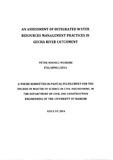| dc.description.abstract | Integrated water resource management (IWRM) approach seeks to achieve sustainable holistic development of water resources in a water catchment. It is a cross cutting issue with multiple institutions involved and harmonization of their efforts is imperative to realize the economic, equitable, and sustainable development of this limited natural resources. Limited documentation of the water resources Management (WRM) practices in Kenya has been done, albeit there are serious concerns that the country is highly water scarce, with less than 526m3/capita/year of fresh water ( world Bank, 2012).
This study, an assessment of IWRM practices in Gucha River catchment,were examined. Gucha River which has its head waters in Kisii highlands is one of the major rivers draining Lake Victoria. The catchment, which covers 2006 km2 has characteristics which range from high agricultural potential to low potential and food insecure areas in lower catchment, where frequent floods are also experienced. Gucha River is also targeted for development mainly for agriculture, power generation, domestic and industrial water use.
The high human population, estimated at 1,460,884 people, also exerts sustainable demand on the water resources in the catchment. | en_US |

